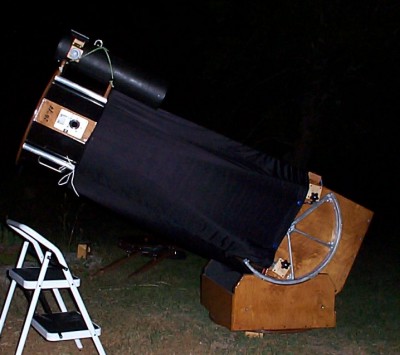|
|
Building 20 inch truss-tube Dobsonian telescope
The courage to undertake this project resulted from successful completion of 24 inch f4.5 Venor Telescope by fellow members of RASC - Kingston Centre. While many construction steps were carried alone in my basement, I have enjoyed a tremendous help of Doug Angle. His persistence and inventiveness cannot be overstated!
To construct my truss-tube telescope, I have generally followed instructions outlined in the book "The Dobsonian Telescope: A Practical Manual to Building Large Aperture Telescopes" by David Kriege and Richard Berry (Willmann-Bell, 1997). While great on woodworking and other construction techniques, it contains only short (though very useful) chapter on making large aperture optics. To tackle mirror making, I dipped extensively into vast knowledge compiled in "Amateur Telescope Making" edited by Albert G. Ingalls (Scientific American, editions: 1928, 1933 and Book Two - 1949). Making a flat diagonal mirror is described on the separate page.
|
|
At the end of February 2002, I finally decided to plunge into it. First step consisted of ordering BVC (black vitrified ceramic) blank from ASM Products in St.Basile, Quebec. To save some time, it was ordered with pre-generated rough f4 curve.
By that time three 7 inch Pyrex disks were polished flat already (all to about 1/16 wave). Two 4.5 inch (minor axis) elliptical mirrors were cut for Venter Scope and the third was cut to make 4 inch secondary for my future beast.
While waining for 20 inch blank (expected to be delivered in late March), I started to build other vital part of the telescope - follow links below for individual steps:
Finished scope is still quite a bit bottom heavy leaving about 2.5 lbs for additional gadgets to be attached to secondary cage (counterweight for now). There is enough room for CCD camera in the future as well ;-)

Scope overview
primary mirror: diameter = 20" (508 mm), FL = 2033.7 mm (f4), enhanced aluminum coating
secondary mirror: minor axis = 4" (101.6 mm), enhanced aluminum coating
finders:
red-dot 1x finder
homebuilt 6" f4 scope (primary and secondary mirrors coated with enhanced aluminum) with 25mm eyepiece (24x)
eyepiece height at zenith: 78" (no ladder needed - just a step stool)
total weight (without wheelbarrow handles): 192 lbs (87.2 kg)
portability: long distance - fits inside Ford Escort stationwagon with room to spare (left image below)
short distance - everything rolls together in one compact package (including step stool)

setup time: 15 min. with practice
construction time: March 2 - July 16, 2002 (not including diagonal)
First light
After some testing and adjustments, the first official night of observing started on the evening of July 30, 2002. After setting up and cooling the scope, I have re-colimated it and then star-hopped to a newly discovered comet 2002 O4. It was noticable in 6 inch finder but 20 inch showed it a7 133x as a quite large oval with point nucleus (no tail, though). Below are two images taken about an hour later with a Cookbook CCD camera on Celestron 8 inch f6.3 SCT (both are 30 sec. unguided exposures). Motion of the comet is quite apparent - UT of midexposure and coordinates of the nucleus are listed. North is up. Only part of the frame is shown. The scale was reduced to 75% as well.


Some other objects observed that night included:
M4 (red giants stand out nicely)
M6 (tested seeing low over horizon, bright orange star on one side of the cluster of blue stars)
Trifid Nebula (beautifully defined dust lanes)
Ink Spot (very low over horizon but still clearly "a hole" in the Milky Way)
Swan Nebula (faint outer loop of nebulosity easy to see as well)
M11 (my all time favourite)
Veil Nebula (well, 20 inch shows a lot, even without nebular filter with rising Last Quarter Moon!)
I have also located Pease 1 planetary in M15 - that was my second challenge for the first light observing! Blinking with nebular filter confirmed sighting of this extremely difficult object.
Number of visitors:
© Jan Wisniewski